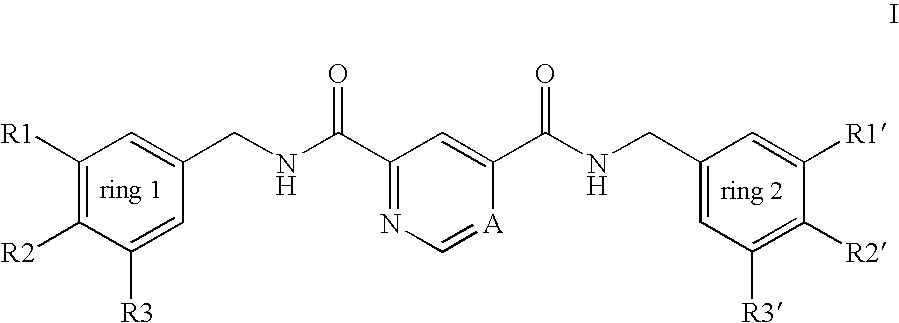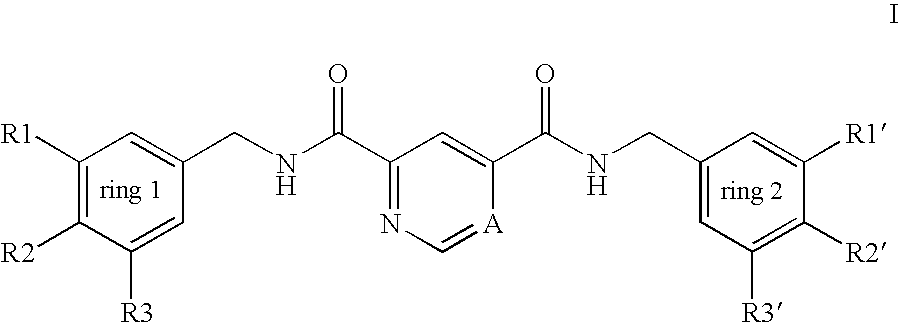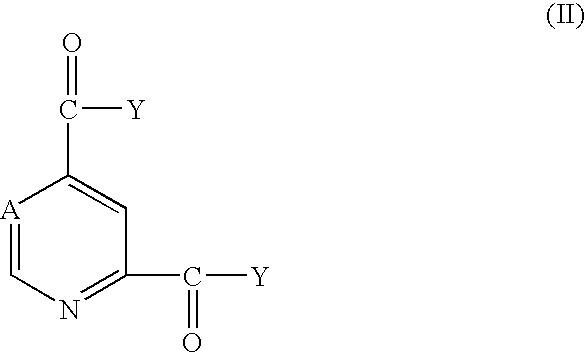Pyridine-2,4-dicarboxylic acid diamides and pyrimidine-4,6-dicarboxylic acid diamides and the use thereof for selectively inhibiting collagenases
a technology of dicarboxylic acid diamides and pyrimidine, which is applied in the direction of biocide, heterocyclic compound active ingredients, drug compositions, etc., can solve the problems of lack of specificity, inability to bind mmp inhibitors, and inability to hydroxylated collagen to be incorporated into collagen matrix
- Summary
- Abstract
- Description
- Claims
- Application Information
AI Technical Summary
Benefits of technology
Problems solved by technology
Method used
Image
Examples
example1
[0105]
[0106] Pyrimidine-4,6-dicarboxylic acid dibenzylamide
[0107] 1.7 g of pyrimidine-4,6-dicarboxylic acid are suspended in 20 ml of toluene and 2.4 g of thionyl chloride and 0.2 ml of dimethylformamide are added. The mixture is heated to reflux until it is no longer possible to observe any gas evolution (about 3 hours (h)). About 5ml of solvent are distilled off and the mixture is then cooled down to from 0.degree.C to 10.degree.C and 2.7 g of benzylamine, dissolved in 10 ml of toluene, are added. The solution is slowly heated to room temperature, then stirred at room temperature for 12 hours and evaporated down to dryness. The residue is taken up in 50 ml of methylene chloride and the solution is extracted 3 times by shaking with saturated sodium hydrogen carbonate solution; the organic phase is washed with water, dried with magnesium sulfate and evaporated.
[0108] The solid is recrystallized from diisopropyl ether. Yield: 2.1 m.p.: 131.degree.C to 132.degree.C.
example 2
[0109]
[0110] Pyrimidine-4,6-dicarboxylic acid bis(3-chloro-4-fluorobenzylamide)
[0111] 9
[0112] 200mg(1.2 mmol) of pyrimidine-4,6-dicarboxylic acid were suspended in 0.3ml(4.1mmol) of thionyl chloride. This mixture was heated at 85.degree.C for 2h while being stirred. After it had been cooled down to room temperature, 2ml of absolute dichloromethane were added. The suspension was cooled down to 0.degree.C and 0.33ml(2.4mmol) of triethylamine was added. 861mg(5.4mmol) of 3-chloro-4-fluorobenzylamine were added while stirring vigorously.
[0113] The mixture was then stirred for further 15 minutes. It was then diluted with 10ml of dichloromethane after which 10ml of water were added. After 5 minutes, the mixture was transferred into a separating funnel and the phases were separated. The organic phase was washed twice with saturated sodium chloride solution and then dried over magnesium sulfate. After filtration, the filtrate was concentrated under reduced pressure and the residue which was...
PUM
| Property | Measurement | Unit |
|---|---|---|
| temperatures | aaaaa | aaaaa |
| temperatures | aaaaa | aaaaa |
| temperatures | aaaaa | aaaaa |
Abstract
Description
Claims
Application Information
 Login to View More
Login to View More - R&D
- Intellectual Property
- Life Sciences
- Materials
- Tech Scout
- Unparalleled Data Quality
- Higher Quality Content
- 60% Fewer Hallucinations
Browse by: Latest US Patents, China's latest patents, Technical Efficacy Thesaurus, Application Domain, Technology Topic, Popular Technical Reports.
© 2025 PatSnap. All rights reserved.Legal|Privacy policy|Modern Slavery Act Transparency Statement|Sitemap|About US| Contact US: help@patsnap.com



